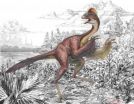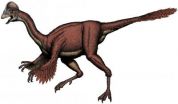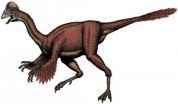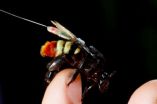(Press-News.org) SALT LAKE CITY, March 19, 2014 – Scientists from Carnegie and Smithsonian museums and the University of Utah today unveiled the discovery, naming and description of a sharp-clawed, 500-pound, bird-like dinosaur that roamed the Dakotas with T. rex 66 million years ago and looked like an 11 ½-foot-long "chicken from hell."
"It was a giant raptor, but with a chicken-like head and presumably feathers. The animal stood about 10 feet tall, so it would be scary as well as absurd to encounter," says University of Utah biology postdoctoral fellow Emma Schachner, a co-author of a new study of the dinosaur. It was published online today in PLOS ONE, a journal of the Public Library of Science.
The study's lead author, Matt Lamanna of the Carnegie Museum of Natural History in Pittsburgh, says: "We jokingly call this thing the 'chicken from hell,' and I think that's pretty appropriate."
The beaked dinosaur's formal name is Anzu wyliei – Anzu after a bird-like demon in Mesopotamian mythology, and wyliei after a boy named Wylie, the dinosaur-loving grandson of a Carnegie Museums of Pittsburgh trustee.
Three partial skeletons of the dinosaur – almost making up a full skeleton – were excavated from the uppermost level of the Hell Creek rock formation in North and South Dakota – a formation known for abundant fossils of Tyrannosaurus rex and Triceratops. The new dinosaur was 11 ½ feet long, almost 5 feet tall at the hip and weighed an estimated 440 to 660 pounds. Its full cast is on display at the Carnegie Museum.
Schachner and Lamanna were joined in the new study and description of three specimens by Hans-Dieter Sues and Tyler Lyson of the Smithsonian Institution's National Museum of Natural History in Washington.
"I am really excited about this discovery because Anzu is the largest oviraptorosaur found in North America," she says. "Oviraptorosaurs are a group of dinosaurs that are closely related to birds and often have strange, cassowary-like crests on their heads." (The cassowary is a flightless bird in New Guinea and Australia related to emus and ostriches.)
Anzu is also "one of the youngest oviraptorosaurs known, meaning it lived very close to the dinosaur extinction event" blamed on an asteroid striking Earth 65 million years ago, Schachner says.
The researchers believe Anzu, with large sharp claws, was an omnivore, eating vegetation, small animals and perhaps eggs while living on a wet floodplain. The dinosaur apparently got into some scrapes.
"Two of the specimens display evidence of pathology," Schachner says. "One appears to have a broken and healed rib, and the other has evidence of some sort of trauma to a toe."
Having a nearly complete skeleton of Anzu wyliei sheds light on a category of oviraptorosaur theropod dinosaurs named caenagnathids, which have been known for a century, but only from limited fossil evidence.
Like many "new" dinosaurs, Anzu wyliei fossils were discovered some years ago, and it took more time for researchers to study the fossils and write and publish a formal scientific description. As a graduate student at the University of Pennsylvania, Schachner helped Lyson excavate the least complete specimen – six bones from the neck, forelimbs and shoulder – in North Dakota. The Carnegie Museum obtained the other specimens.
At a scientific meeting in 2005 Lamanna, Lyson and Schachner realized they had fossils of the same new species of dinosaur. They soon began collaborating on the new study and asked Sues to join them because he was an expert on this type of dinosaur, Schachner says.
"It took years since all of us had busy schedules, and I moved to Utah in 2010 to work on reptile respiratory evolution," she says.
The study's four authors finally met for a week at the Carnegie Museum to work on the dinosaur together. Among other tasks, Schachner illustrated and photographed some of the bones.
She says the process was "really exciting. Naming a dinosaur is one of those things I've wanted to be involved in since I was a kid."
INFORMATION:
After the embargo expires, the study will be online here:
http://dx.plos.org/10.1371/journal.pone.0092022
University of Utah Communications
75 Fort Douglas Boulevard, Salt Lake City, UT 84113
801-581-6773 fax: 801-585-3350
http://www.unews.utah.edu
A 'chicken from hell' dinosaur
University of Utah postdoc co-authors study of fowl-looking creature
2014-03-19
ELSE PRESS RELEASES FROM THIS DATE:
Smithsonian collaborates with paleontologist team to reveal new large, feathered dinosaur
2014-03-19
A team of scientists from the Smithsonian's National Museum of Natural History, the Carnegie Museum of Natural History and the University of Utah has described an unusual bird-like dinosaur previously unknown to science, resembling a cross between a modern emu and a reptile. The new species, Anzu wyliei, lived 68 to 66 million years ago and was identified from three partial skeletons collected from the Upper Cretaceous Hell Creek Formation in North and South Dakota. The species belongs to Oviraptorosauria, a group of dinosaurs mostly known from fossils found in Central ...
Paleontologists announce discovery of Anzu wyliei
2014-03-19
Pittsburgh, Pennsylvania…A team of researchers has announced the discovery of a bizarre, bird-like dinosaur, named Anzu wyliei, that provides paleontologists with their first good look at a dinosaur group that has been shrouded in mystery for almost a century. Anzu was described from three specimens that collectively preserve almost the entire skeleton, giving scientists a remarkable opportunity to study the anatomy and evolutionary relationships of Caenagnathidae (pronounced SEE-nuh-NAY-thih-DAY)—the long-mysterious group of theropod dinosaurs to which Anzu belongs. The ...
High-frequency breathing support for premature babies could lead to better lung function
2014-03-19
A new study led by researchers at King's College London has found that premature babies supported immediately after birth by high-frequency oscillation - a type of breathing support - had better lung function as adolescents than those who received conventional ventilation. The children ventilated with the high frequency method also showed higher academic achievement in three of eight school subjects.
The findings of the research, funded by the National Institute for Health Research (NIHR) Health Technology Assessment (HTA) Programme and the NIHR Biomedical Research Centre ...
Studies advance potential use Of MRI magnetic fields to treat balance disorders
2014-03-19
Expanding on earlier research, Johns Hopkins researchers report that people with balance disorders or dizziness traceable to an inner-ear disturbance show distinctive abnormal eye movements when the affected ear is exposed to the strong pull of an MRI's magnetic field.
The researchers first reported in 2011 in the journal Current Biology that an MRI's magnetic field pushes on the inner ear fluid responsible for maintaining balance, causing subjects undergoing MRI scans to have jerky eye movements and dizziness.
Two new studies now suggest that these strong magnets could ...
New guidelines deem 13 million more Americans eligible for statins
2014-03-19
DURHAM, N.C. – New guidelines for using statins to treat high cholesterol and prevent cardiovascular disease are projected to result in 12.8 million more U.S. adults taking the drugs, according to a research team led by Duke Medicine scientists.
The findings for the first time quantify the impact of the American Heart Association's new guidelines, which were issued in November and generated both controversy and speculation about who should be given a prescription for statins.
In an analysis of health data published online March 19, 2014, in the New England Journal ...
Tracking endangered leatherback sea turtles by satellite, key habitats identified
2014-03-19
AMHERST, Mass. ¬– A first-of-its-kind satellite tagging study of migrating New England leatherback turtles in the North Atlantic offers a greatly improved understanding of their seasonal high-use habitats, diving activity and response to key ocean and environmental features in relation to their search behavior. Leatherbacks are considered endangered species in all the world's oceans.
The study, part of doctoral research by Kara Dodge supervised by her advisor, Molly Lutcavage of the University of Massachusetts Amherst's Large Pelagics Research Center (LPRC) in Gloucester, ...
North Shore-LIJ Cancer Institute doctors' editorial published
2014-03-19
LAKE SUCCESS, NY – Two North Shore-LIJ Cancer Institute doctors, world-renowned for their research in chronic lymphocytic leukemia (CLL), weigh in on a German study of a new drug therapy for CLL in the March 20 edition of the New England Journal of Medicine, the North Shore-LIJ Health System announced today.
CLL is one of the most common forms of blood cancers, usually affecting those later in life. In an editorial written by Kanti Rai, MD, chief of CLL Research and Treatment Program for the health system, and Jacqueline Barrientos, MD, a research hematologist on staff ...
Dry future climate could reduce orchid bee habitat
2014-03-19
ITHACA, N.Y. – During Pleistocene era climate changes, neotropical orchid bees that relied on year-round warmth and wet weather found their habitats reduced by 30 to 50 percent, according to a Cornell University study that used computer models and genetic data to understand bee distributions during past climate changes.
In previous studies, researchers have tracked male and female orchid bees and found that while females stay near their nests, male orchid bees travel, with one study concluding they roam as far as 7 kilometers per day. These past findings, corroborated ...
Diabetes in middle age may lead to brain cell loss later in life
2014-03-19
MINNEAPOLIS – People who develop diabetes and high blood pressure in middle age are more likely to have brain cell loss and other damage to the brain, as well as problems with memory and thinking skills, than people who never have diabetes or high blood pressure or who develop it in old age, according to a new study published in the March 19, 2014, online issue of Neurology®, the medical journal of the American Academy of Neurology. Middle age was defined as age 40 to 64 and old age as age 65 and older.
"Potentially, if we can prevent or control diabetes and high blood ...
Ruling with an iron fist could make your child pack on pounds
2014-03-19
If you're rigid with rules and skimpy on affection and dialogue with your kids, they have a greater chance of being obese, according to research presented at the American Heart Association's Epidemiology & Prevention/Nutrition, Physical Activity & Metabolism Scientific Sessions 2014.
Researchers followed a nationally representative group of 37,577 Canadian children aged 0 to 11. They compared kids whose parents are generally affectionate, have reasonable discussions about behavior with their child and set healthy boundaries (authoritative) with those whose parents were ...
LAST 30 PRESS RELEASES:
Making lighter work of calculating fluid and heat flow
Normalizing blood sugar can halve heart attack risk
Lowering blood sugar cuts heart attack risk in people with prediabetes
Study links genetic variants to risk of blinding eye disease in premature infants
Non-opioid ‘pain sponge’ therapy halts cartilage degeneration and relieves chronic pain
AI can pick up cultural values by mimicking how kids learn
China’s ecological redlines offer fast track to 30 x 30 global conservation goal
Invisible indoor threats: emerging household contaminants and their growing risks to human health
Adding antibody treatment to chemo boosts outcomes for children with rare cancer
Germline pathogenic variants among women without a history of breast cancer
Tanning beds triple melanoma risk, potentially causing broad DNA damage
Unique bond identified as key to viral infection speed
Indoor tanning makes youthful skin much older on a genetic level
Mouse model sheds new light on the causes and potential solutions to human GI problems linked to muscular dystrophy
The Journal of Nuclear Medicine ahead-of-print tip sheet: December 12, 2025
Smarter tools for peering into the microscopic world
Applications open for funding to conduct research in the Kinsey Institute archives
Global measure underestimates the severity of food insecurity
Child survivors of critical illness are missing out on timely follow up care
Risk-based vs annual breast cancer screening / the WISDOM randomized clinical trial
University of Toronto launches Electric Vehicle Innovation Ontario to accelerate advanced EV technologies and build Canada’s innovation advantage
Early relapse predicts poor outcomes in aggressive blood cancer
American College of Lifestyle Medicine applauds two CMS models aligned with lifestyle medicine practice and reimbursement
Clinical trial finds cannabis use not a barrier to quitting nicotine vaping
Supplemental nutrition assistance program policies and food insecurity
Switching immune cells to “night mode” could limit damage after a heart attack, study suggests
URI-based Global RIghts Project report spotlights continued troubling trends in worldwide inhumane treatment
Neutrophils are less aggressive at night, explaining why nighttime heart attacks cause less damage than daytime events
Menopausal hormone therapy may not pose breast cancer risk for women with BRCA mutations
Mobile health tool may improve quality of life for adolescent and young adult breast cancer survivors
[Press-News.org] A 'chicken from hell' dinosaurUniversity of Utah postdoc co-authors study of fowl-looking creature




